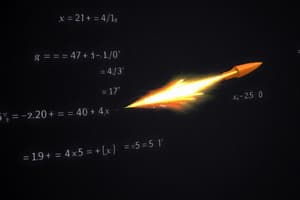Podcast
Questions and Answers
What are the components of velocity denoted by v_x and v_y in projectile motion?
What are the components of velocity denoted by v_x and v_y in projectile motion?
- v_x represents the horizontal component and v_y represents the vertical component (correct)
- v_x represents the vertical component and v_y represents the horizontal component
- v_x represents the displacement in the x-direction and v_y represents the displacement in the y-direction
- v_x represents the acceleration in the x-direction and v_y represents the acceleration in the y-direction
In Table 3-2, which direction is taken as positive for y in projectile motion?
In Table 3-2, which direction is taken as positive for y in projectile motion?
- Horizontal
- Upward (correct)
- Diagonal
- Downward
How can Eqs 2-11 be simplified for projectile motion?
How can Eqs 2-11 be simplified for projectile motion?
- By setting a_x = -9.80 m/s² and a_y = g
- By setting a_x = g and a_y = -9.80 m/s²
- By setting a_x = -g and a_y = 0
- By setting a_x = 0 and a_y = -g (correct)
What is the value of acceleration (a_y) due to gravity during projectile motion assuming y is positive upward?
What is the value of acceleration (a_y) due to gravity during projectile motion assuming y is positive upward?
If y is taken as positive downward in projectile motion, what happens to the signs in front of g?
If y is taken as positive downward in projectile motion, what happens to the signs in front of g?
In Fig. 3-20, what does the projection angle θ (theta) represent in relation to the +x axis?
In Fig. 3-20, what does the projection angle θ (theta) represent in relation to the +x axis?
Flashcards are hidden until you start studying
Study Notes
Projectile Motion Components
- In projectile motion, velocity can be broken down into two components: v_x (horizontal) and v_y (vertical).
Direction of y in Projectile Motion
- In Table 3-2, the positive direction for y is taken as upward.
Simplifying Equations for Projectile Motion
- Eqs 2-11 can be simplified for projectile motion.
Acceleration due to Gravity
- The acceleration due to gravity (a_y) during projectile motion is equal to -g, where g is 9.8 m/s², assuming y is positive upward.
Alternative Direction for y
- If y is taken as positive downward, the signs in front of g change.
Projection Angle θ (theta)
- In Fig. 3-20, the projection angle θ (theta) represents the angle of projection relative to the +x axis.
Studying That Suits You
Use AI to generate personalized quizzes and flashcards to suit your learning preferences.




